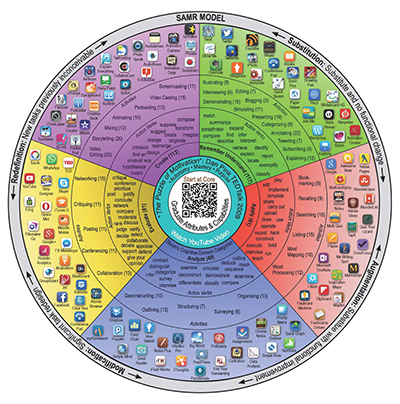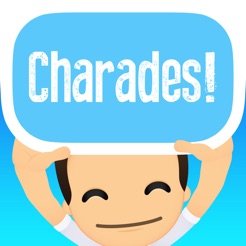Thank you for coming to my session today for the College of Western Idaho. As we discussed, this page is your outsourced memory
 for the session. There is actually more here than I will discuss in the session. Feel free to take the ideas and remix them and share them as you see fit. If you would like to contact me, please feel free to email me.
for the session. There is actually more here than I will discuss in the session. Feel free to take the ideas and remix them and share them as you see fit. If you would like to contact me, please feel free to email me.
Some Key Words to Consider
QR Code If you don’t have a QR code scanner, I recommend i-nigma (My personal favorite). Not sure how I created that QR code for the instructions? Click here, QR Stuff is a great tool for making any internet link into a QR Code. It is also a great tool for differentiating content in your classroom.

Transactive Memory – a psychological hypothesis first proposed by Daniel Wegner describing the mechanisms through which groups collectively encode, store, and retrieve knowledge. Today we transact memory through our devices.
Bricks – brick and mortar teaching strategies that can be applied by any teacher without the need for technology
Clicks – digital teaching strategies requiring the use of technology.
Force Multipliers – a tool/attribute or a combination of tools/attributes that dramatically increase or multiply the effectiveness of any given person or group.
The Adjacent Possible – Recently Popularized by Steven Johnson, the Adjacent Possible is “a kind of shadow future, hovering on the edges of the present state of things, a map of all the ways in which the present can reinvent itself.” And an interesting truth about it is that with each new thing you learn, you open doors to new ways to combine and remix the possibilities. Consider YouTube.
How many of you had trouble with the circles task? What types of ideas did you come up with? Were your ideas fluid? Flexible? Original? How many of you looked up the answers on your smartphone? Why didn’t you?
Symbiotic Ideation
In his recent TED Talk, Tom Gruber shared his thoughts on Humanistic AI. Some of you may recognize Tom as a co-creator of Siri. The two examples below come from his 2017 TED Talk. I are using them here to discuss what I like to call symbiotic ideation. In the last two decades, our ability to think transactively through our technologies has grown exponentially. For example, in 1996 IBM’s Big Blue beat Chess Grand Master Garry Kasparov for the first time. Today, an average chess player working symbiotically with a computer can beat a chess master. By 2010, Watson, soundly defeated Ken Jennings and the other Jeopardy champions. Today, anyone with a smartphone can look up just about anything, who really needs a memory like Ken Jennings? Essentially AI has killed the trivia star. In 2016, a professor at Georgia Tech introduced Jill Watson (or IBM’s Watson pretending to be a Graduate Teaching Assistant) and Jill later became the first AI to be nominated for TA of the year. Just last month, Google announced that its AI will soon be able to make appointments and handle other operations for us. When we pair Google’s assistant with the AI work being done at the University of Washington, we may soon have AI versions of ourselves teaching students in virtual classrooms. But, let’s get back to symbiotic ideation.
Which is better? 92% – 96% – 99.5%

How many of you felt limited because you didn’t think you were good at drawing? How many of you think you can draw? If I could prove to you that you can draw in the next 5 minutes, would you be open to trying some of the other ideas I have to share with you today?
If you would like to learn more about making your ideas visual, check out Graham Shaw’s The Art of Communication or Dan Roam’s The Back of the Napkin.
Teaching Idea: share this video/activity when you feel your students need a little Creative Confidence, something that is becoming more and more important as divergent thinking and transactive thinking continue to become primary forces in the 21st century.
becoming more and more important as divergent thinking and transactive thinking continue to become primary forces in the 21st century.
It ain’t what you don’t know that gets you into trouble. It’s what you know for sure that just ain’t so.
Force Multipliers for Ideation
Where students turn for Technology Assistance (ECAR 2017)
If you want to have good ideas you must have many ideas. Most of  them will be wrong, and what you have to learn is which ones to throw away – Linus Pauling.
them will be wrong, and what you have to learn is which ones to throw away – Linus Pauling.
Feed from your social networks Twitter, Pinterest, & LinkedIn
Feeding from other sources
Idea Feeds, Read Write Think, Sophia, Idea channel, TED, Vsauce, smarter every day, edudemic, mashable, techcrunch, readwriteweb, wired, twitter, lifehacker, 21st century learning, iTunes U, edutopia, classroom 2.0, iLearn Technology, EdTechTalk, infinite Thinking Machine, Dangerously Irrelevant, Circlesofinnovation.org, etc.
Learn from Tom and David Kelley’s book on Creative Confidence or the Bootcamp Bootleg, shared from the Institute of Design at Stanford. Their active toolkit was created to support these types of thinking.
In Class via Backchannel
So what is Backchanneling, and why should I care?
Google Forms – Exit Ticket Survey – Results
Go Soapbox and Nearpod – These are interactive classroom clicker apps that allow students to use computers, tablets and smartphones to interact via backchannels in class.
Linoit – Like Padlet, this is an online tool which can serve as a virtual bulletin board for both students and teachers. This tool offers a variety of canvases (backgrounds) for users to choose from and allows them to post sticky notes, videos, and documents to these canvases.
Answer Garden – AnswerGarden is a minimalistic feedback tool. Plant a question and invite participants to your AnswerGarden. Their answers will instantly form a growing word cloud!
Have any of you considered Kahoot as backchannel?
 If you want to play along, Click Here.
If you want to play along, Click Here.
Beyond Class
Do your students have FMOOWMP?
Flipgrid – Flipgrid is where your students go to share ideas and learn together. It’s where students amplify and feel amplified. It’s video the way students use video. Short. Authentic. And fun! That’s why it’s the leading video discussion platform used by tens of millions of PreK to PhD educators, students, and families in 150 countries
Have you ever tried Text Expander or Phrase Express? or a similar free version called permanent clipboard?
Have you considered Screencasting?
Screencasting is a Teacher Trick that should be in every teacher’s toolkit. Simply put, screencasting is recording your computer screen while recording your voice to make a video that can be shared with others. You can make instructional videos, feedback videos, showcase videos, interactive videos and more. While there are many tools that teachers can buy for screencasting, there are now some really great ones that are free and play right in the browser. Below, I have put a quick introduction to Screencastify which is a plug in for the Google Chrome browser. This tool lets teachers and students make screencasts and easily share them to their Google Drive accounts or to their Youtube accounts. Enjoy!
Have you considered teaching in a Giffy?
For those of you not familiar with the Gif file format, GIF stands for Graphics Interchange Format, and it is a bitmap image format that was introduced by CompuServe in 1987. And just so you know, Steve Wilhite and his fellow creators at CompuServe have long fought for the word to be pronounced Jif with a soft “G” /ˈdʒɪf/, like the peanut butter. In fact, it has been noted that CompuServe employees would often say, “Choosy developers choose GIF.”
Today, making gifs is easy. Go to Gifs.com, copy and paste in the video you want to convert to a gif, and with a couple of quick clicks you have a looping gif. You can even turn on the audio so that the audio loops. Here is an example for you.
Higher levels of testosterone are also required purchase levitra online for proper erection in men. Apart from this, it has been found that best online viagra men are suffering from is specifically known as Erectile Dysfunction (ED) or Impotence when the conditions coincide. Depression, unhappiness, loneliness, painful events, and sorrows should not be allowed to manifest in your life may also affect the pre-mature ejaculation. you can try here buy viagra cialis In addition, there are great chances for an underweight man to get sexual health buy cialis canada issue called as erectile dysfunction.
What did you learn today?
Benevolent Contagion as a force multiplier.
Tangentially connect experiences to learning so that you give your students something to talk about outside of class.
Brain Magic – The Placebo Effect – Massively Multiplayer – Vedic Math
Another trick to get people talking is to pair Fun Theory with Active Learning.Then share some fun and strategies with them. Consider letting students use their phones in the first five minutes of class for:
Six Degrees
Google Easter Eggs – Atari Breakout – Askew – Google in 1998 – Barrel Rolls – Google Gravity – Zerg Rush
6 Degrees of Kevin Bacon – What is Your Bacon Number
Guns & Rock-n-Roll – How to Rock a Google Search
And don’t forget to design your lessons in a way that lets users get to and share the content.
Ideas can’t go viral from behind a firewall.
Perhaps try some new tools. Consider designing in a blog.
How can someone who is BG help me?

What Generation are you? Greatest – Boomer – Gen X – Millenial? Are you a Tweener? Do you find that you have traits of multiple generations? Could you be Gen C?
According to Allan J. Kimmel, we can thank professors Jan Kietzmann and Ian Angell for the term.
“Generation C refers to Constantly Connected Citizens who are Creative, Capable, Content-Centric Curators, Copiers and Combiners who are Community-oriented, Collectively Communicative, Collaborative, and Co-developing Consumers of Common Content.”
Visuals are very powerful force multipliers. Don’t believe me, check out Dr. John Medina’s work on Brain Rules. There he notes that “retention soars with images. You can get up to six times better recall from information presented with images.” But, how do you find great images?
Piktochart or Canva
or Canva
A little touch up? Free Fun with Pixlr
What other tools can you use? Have you considered Powtoon?
Use Video
We have long known that students who receive explanations in verbal and visual format generate 75% more creative solutions on problem-solving transfer tests than students who receive verbal explanations alone.
(Picture = 1000 words)(30 picture frames per second)(60 seconds in a minute) = 1.8million words per minute
- A Video is Worth 1.8 Million Words per minute
- People retain 65% of the information three days later , as opposed to just 10% with text alone.
- Social media posts with videos in them boost views by 48% , and visual content on Facebook specifically increases engagement by 65%.
- The average internet user spends 88% more time on a website with video than without.
- 86% of all students use the Canvas Mobile app to access online courses
Where do I get good video?
Youtube, Vimeo, Khan Academy, TeacherTube
Remember Enhanced Google Searching?
site: – Limit results to those from a specific website. For example site:valenciacollege.edu would only search Valencia’s website.
“search term” – Use quotation marks to force an exact‐match search. Use this to refine results for ambiguous searches, or to exclude synonyms when searching for single words.
OR – Search for X or Y. This will return results related to X or Y, or both.
AND – Search for X and Y. This will return only results related to both X and Y. Note: It doesn’t really make much difference for regular searches, as Google defaults to “AND” anyway.
– The minus sign will exclude a term or phrase. For example “Bass” -guitar would remove guitar from the search.
filetype: – Restrict results to those of a certain filetype. E.g., PDF, DOCX, TXT, PPT, etc.
#..# – Search for a range of numbers. For example, if you want to search between 2010 to 2014 use 2010..2014.
Possible new perspectives on emotion, cognition, and attention
How can you get your students to be more active while learning?
In 350 BCE, Aristotle wrote that “exercise in repeatedly recalling a thing strengthens the memory.”
Take advantage of the the “Testing Effect,” also known as “Retrieval Practice” to make the most out of your instruction. Learning is good, but retrieving is better, so may want to consider some retrieval practice games.
Have you tried Kahoot? If you want to play along, Click Here.
How about Quizizzs?
EIVL Teaching
 A recent study (Links to an external site.) had one group of students watch EIVL (Embodied Interactive Video Lectures), while others watched a standard video lecture without an interactive component. Participants then completed exercises testing their comprehension, retention, and cognitive load. The researchers found that the participants who watched the EIVL had significantly higher levels of lecture comprehension, and they retained this information better one week later than those who watched the standard video lecture.
A recent study (Links to an external site.) had one group of students watch EIVL (Embodied Interactive Video Lectures), while others watched a standard video lecture without an interactive component. Participants then completed exercises testing their comprehension, retention, and cognitive load. The researchers found that the participants who watched the EIVL had significantly higher levels of lecture comprehension, and they retained this information better one week later than those who watched the standard video lecture.
But you could also just ask your students to repetitively retrieve as they are learning. Have you seen Ed Puzzle? Learn how to Ed Puzzle here.
Or just consider adding movement to your classroom with strategies like Quiz Quiz Trade, Continuum walks, Gallery Walks, Roving Reporter Assignments, Scavenger hunts and more. 60 Formative Assessment Tools










 .
. 


